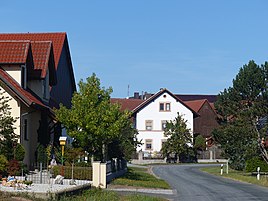Stiebarlimbach
|
Stiebarlimbach
Community Hallerndorf
Coordinates: 49 ° 45 ′ 19 ″ N , 10 ° 56 ′ 49 ″ E
|
|
|---|---|
| Height : | 285 (277-288) m above sea level NHN |
| Residents : | 67 (1987) |
| Postal code : | 91352 |
| Area code : | 09195 |
|
The Hallerndorfer district of Stiebarlimbach
|
|
Stiebarlimbach is a Franconian village that belongs to Hallerndorf .
geography
The village , located in the natural landscape of the Bamberg Rhaet-Lias hill country , is one of nine officially named districts of the municipality of Hallerndorf in Upper Franconia . It is located about two and a half kilometers west-southwest of the center of Hallerndorf at an altitude of 285 m above sea level. NHN .
history
The name of the place goes back to the noble family von Stiebar , who owned a now defunct castle in the village. Until the beginning of the 19th century, Stiebarlimbach was under the sovereignty of the Bamberg Monastery . The Ebrach monastery , a media of the bishopric , exercised the authority of the village and community , which was decisive for the sovereignty of the Franconian region . The Bamberg office of Bechhofen in Zentbechhofen as a central office exercised the high jurisdiction .
When the Bamberg Monastery was secularized as a result of the Reichsdeputationshauptschluss 1802/03 and annexed by the Electorate Palatinate-Baiern in breach of the Imperial Constitution , Stiebarlimbach became part of the New Bavarian territories that were forcibly taken over during the Napoleonic land consolidation .
Due to the administrative reforms in the Kingdom of Bavaria at the beginning of the 19th century , Stiebarlimbach became part of the independent rural community of Schnaid with the Second Community Edict in 1818 . In the course of the municipal territorial reform in Bavaria in the 1970s, Stiebarlimbach and Schnaid were incorporated into the Hallerndorf community at the beginning of 1974. In 1987 Stiebarlimbach had 67 inhabitants.
traffic
The district road FO 10 coming from Willersdorf leads past the south and north-western outskirts of the village and continues to Schnaid. From this the district road FO 19 branches off in the direction of Greuth , which becomes ERH 17 after crossing the district border . The public transport serving the village at a bus stop for line 265 of the VGN . The nearest train station on the Nuremberg – Bamberg line is in the Eggolsheim district of Neuses .
Attractions
There are six listed buildings in and around Stiebarlimbach, including a farm and a draw well.
literature
- Ingomar Bog: Forchheim . In: Historical Atlas of Bavaria . Commission for Bavarian State History, Munich 1955.
- Johann Kaspar Bundschuh : Stiebarlimbach . In: Geographical Statistical-Topographical Lexicon of Franconia . tape 5 : S-U . Verlag der Stettinische Buchhandlung, Ulm 1802, DNB 790364328 , OCLC 833753112 , Sp. 446 ( digitized version ).
- Federal Statistical Office (Hrsg.): Historical municipality register for the Federal Republic of Germany. Name, border and key number changes in municipalities, counties and administrative districts from May 27, 1970 to December 31, 1982 . W. Kohlhammer, Stuttgart / Mainz 1983, ISBN 3-17-003263-1 .
Web links
- Bavarian authorities guide for Stiebarlimbach , accessed on September 23, 2019
- Stiebarlimbach in the BayernAtlas , accessed on September 23, 2019
- Stiebarlimbach on a historical map , accessed on September 23, 2019
- Stiebarlimbach in the Topographia Franconiae of the University of Würzburg , accessed on September 23, 2019.
Individual evidence
- ↑ a b Bavarian State Office for Statistics and Data Processing (Ed.): Official local directory for Bavaria, territorial status: May 25, 1987 . Issue 450 of the articles on Bavaria's statistics. Munich November 1991, DNB 94240937X , p. 302 ( digitized version ). Retrieved September 23, 2019
- ^ Stiebarlimbach in the local database of the Bayerische Landesbibliothek Online . Bayerische Staatsbibliothek, accessed on September 23, 2019.
- ↑ Geographical location of Stiebarlimbach in the Bayern Atlas , accessed on September 23, 2019
- ↑ Description of the location of Stiebarlimbach on the website of the Hallerndorf community , accessed on September 24, 2019
- ↑ Gertrud Diepolder : Bavarian History Atlas . Ed .: Max Spindler . Bayerischer Schulbuch Verlag, Munich 1969, ISBN 3-7627-0723-5 , p. 31 .
- ↑ Gertrud Diepolder : Bavarian History Atlas . Ed .: Max Spindler . Bayerischer Schulbuch Verlag, Munich 1969, ISBN 3-7627-0723-5 , p. 97-103 .
- ↑ Gertrud Diepolder : Bavarian History Atlas . Ed .: Max Spindler . Bayerischer Schulbuch Verlag, Munich 1969, ISBN 3-7627-0723-5 , p. 33 .
- ^ Johann Kaspar Bundschuh : Unterstürmig . In: Geographical Statistical-Topographical Lexicon of Franconia . tape 5 : S-U . Verlag der Stettinische Buchhandlung, Ulm 1802, DNB 790364328 , OCLC 833753112 , Sp. 446 ( digitized version ).
- ^ Ingomar Bog: Forchheim . In: Historical Atlas of Bavaria . "Hochgerichtkarte" card supplement .
- ↑ Gertrud Diepolder : Bavarian History Atlas . Ed .: Max Spindler . Bayerischer Schulbuch Verlag, Munich 1969, ISBN 3-7627-0723-5 , p. 35 .
- ↑ Gertrud Diepolder : Bavarian History Atlas . Ed .: Max Spindler . Bayerischer Schulbuch Verlag, Munich 1969, ISBN 3-7627-0723-5 , p. 106-107 .
- ^ Ingomar Bog: Forchheim . In: Historical Atlas of Bavaria . S. 124 .
- ^ Federal Statistical Office (ed.): Historical municipality directory for the Federal Republic of Germany. Name, border and key number changes in municipalities, counties and administrative districts from May 27, 1970 to December 31, 1982 . W. Kohlhammer, Stuttgart / Mainz 1983, ISBN 3-17-003263-1 , p. 683 .

